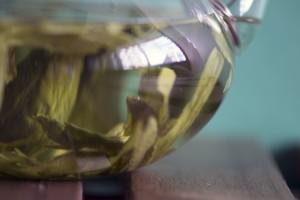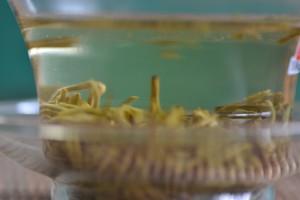Due to a combination of low quality offerings, improper storage and poor brewing techniques, most people do not have a favorable impression of the gastronomic value of green tea.
Don’t fret we have some quick tips for you to get great tasting green tea and enjoy it to the fullest:
1) Watch the Temperature
Thanks to the widespread popularity of black tea, most people use boiling or near boiling water for tea.

Due to the fact that green teas have higher levels of polyphenol and are made from more tender buds, high heat destroys the taste of green tea leaving a bitter, astringent brew.
If you are unsure, a recommended starting point is 80⁰C for most Chinese green teas or if you don’t have the equipment to measure that let boiling water cool in a cup or a cha hai for 2 to 2.5 minutes (based on ambient temperature of ~25⁰C).
This preserves the sweet, brisk taste in tea, provided……
2) Watch the Infusion Time
Or simply put, don’t allow to leaves to soak in the water indefinitely.
When tea leaves are infused, heat causes certain substances such as polyphenols, amino acids to dissolve in the water, transforming it into liquid tea.
Infusing or steeping for too long a period would result in a bitter and unpleasant brew. Hence, after the set infusion time, either pour out the tea completely or remove the tea from the liquid.
While this is largely dependent on personal preference and the tea itself, we recommend a starting point of about 2 minutes.
3) Too much of a good thing
You can have too much of a good thing.
Too much leaves added and the tea tastes bitter and astringent.
Of course too little, it tastes bland.
For green tea, we recommend 1 gram for every 50 ml.
For those who don’t have a weighing scale that measure to the nearest gram, our brewing instructions are expressed in terms of the supplied measuring spatula as well.
4) Storage
Because green tea is un-oxidized, it retains the highest percentage of Catechins.

High moisture content also leads to degradation of green tea.
What these means is simply this: store green tea away from oxygen, heat and moisture.
The details can be found in this article but the Cliff Notes are as follows:
i) Store in a container that is air-tight and opaque- such as metal canisters or aluminum lined PET bags
ii) Seal tightly
iii) Store in a refrigerator if tightly sealed- i.e. prior to opening the package- and allow it to settle half an hour after removing from the fridge to prevent moisture condensation
iv) Consume 2-3 months after opening for maximum freshness
5) Packaging
Related to the point above, packaging is important beyond aesthetics. If it was stored in paper wrapped with a flimsy foil, the air-tightness is suspect.
Even worse are packaging that are either translucent or worse transparent. It may be aesthetically pleasing but it allows light to trigger the degradation in the tea quality.
6) Quality Matters
None of 1-5 matters if the tea in question is low quality. Well-stored crummy tea is fresh but still crummy.
You can get some visual clues to quality but here are some implications:

ii) In production of lower grade green tea, teas tend to be poorly handled resulting to higher oxidation
iii) Poor shaqing technique or equipment results in uneven oxidation levels
Whether your main motivation for drinking green tea is the gastronomic delight or salutary health benefits quality matters.
7) Brewing Techniques
Brewing of green tea is simpler than oolong tea for example but here are some main pointers:
i) Don’t cover the lid of the tea pot or gaiwan completely if you are brewing green tea, it winds up tasting ‘over-stewed’
ii) If the leaves are very brittle and sinks easily- using top drop method
If they tend not to sink easily- use mid-drop.
If the leaves are flat and larger- use bottom drop.
iii) Always warm the pot as an un-warmed pot could cause as much as 10⁰C drop in water temperature
iv) If you have a lid, don’t cover the lid in between steeping- at least until the leaves cool- as it tends to overheat the leaves causing them to lose their freshness.
v) Green tea can be re-infused 3-4 times but don’t leave it overnight as bacteria can build up easily, especially when aided by ambient heat and sunlight.
8 ) Traditional Chinese Medicine wisdom
Green tea is considered ‘cold’ (寒) in TCM nomenclature.
This makes it excellent on hot days but at the same time caution should be exercised:
i) Don’t drink tea that has grown cold, especially green tea as this damage the digestives
ii) Don’t drink tea on an empty stomach as it irritates our stomach
iii) Older folks or those with gastric problems should restrict their intake of green tea
